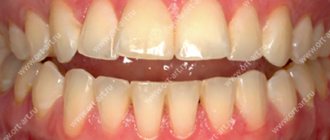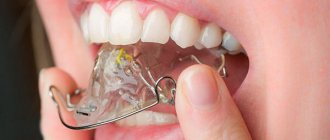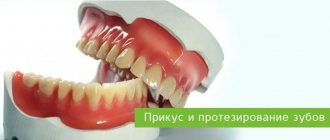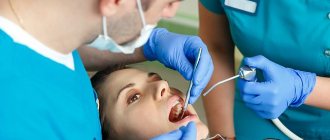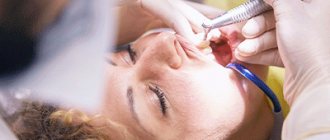One of the most common orthodontic disorders found in adults and children is deep bite. This is what experts call the type of closure of the dental arches, when the upper teeth cover the lower teeth by more than 1/3. In this case, the cutting-tubercle contact between them is disrupted.
This deviation in dentistry is also called vertical deviation of occlusion. Also used are names such as traumatic or decreasing bite, deep frontal or incisal overlap, as well as deep incisal occlusion or diocclusion. All these synonyms mean the same violation.
Causes
The reasons why such a deviation occurs can be congenital or acquired. The most common of them:
- genetic predisposition;
- congenital facial anomalies – cleft palate, cleft lip, etc.;
- a case of severe infectious disease of the mother during pregnancy;
- pathological childbirth with a period of fetal hypoxia;
- diseases in infancy and preschool age associated with dysfunction of the endocrine and respiratory systems, gastrointestinal tract, metabolic disorders;
- incorrect posture and pathologies of the development of the musculoskeletal system;
- gum tumors;
- injuries to the oral cavity or facial part of the skull;
- impaired swallowing and chewing;
- bad habits such as thumb sucking, biting the lower lip, or prolonged pacifier sucking.
Most problems, such as incorrect attachment of the frenulum of the tongue and lips, untimely replacement of primary teeth, early loss of primary molars and premolars, and dental diseases can be prevented or corrected by timely preventive care at the dentist.
In adulthood, this deviation most often results from pathological abrasion of teeth caused by looseness of bone tissue or uneven load when chewing on individual areas of the dentofacial apparatus. Incisal occlusion can result from an accident or other trauma to the skull, for example, after unsuccessful rehabilitation of rhinoplasty and other plastic surgery on the face.
Tooth wear due to deep bite
Four Main Causes of Abnormal Occlusion
- Disturbances during artificial feeding. The upper jaw of newborns is always slightly larger than the lower jaw, and if the hole in the bottle nipple is too large, then the lower jaw does not function, which deprives the child of the opportunity to correct the bite naturally. To avoid complications, parents should select nipples with a small hole for their baby, then the lower jaw will actively develop.
- Bad habits. Extra space between a child's teeth can be a result of thumb sucking or even poor posture. In such cases, consult a doctor to receive recommendations for correction and a set of devices for leveling the occlusion.
- Consequences of diseases. Breathing through the mouth instead of the nose and constantly opening the lower jaw, which often occurs during acute respiratory diseases, can cause the formation of improper occlusion and even an adenoid type of face.
- Heredity. Even if only one of the parents has an incorrect bite, space between teeth or other occlusion abnormalities, there is a risk of passing the defect on by inheritance. Moreover, in each subsequent generation the defect will be even more pronounced.
Signs
Deep bite causes a number of visual aesthetic defects and functional disorders. A person with vertical incisal occlusion has a shortened lower part of the face, the lower lip may be slightly turned outward, and a sharp groove appears above the chin. When smiling, the lower dental arch remains hidden behind the lip.
The main symptom of deep incisive occlusion is the overlap of the lower teeth by the upper teeth by more than 1/3. In this case, the upper jaw looks overhanging. Due to the disorder, the oral mucosa is chronically injured, so the patient periodically experiences episodes of stomatitis; gingivitis, periodontitis and periodontal disease may occur. In most cases, diocclusion causes hypertonicity of the masticatory muscles.
Manifestations of an open bite
Like other dental anomalies, open bite is characterized by facial and oral manifestations:
- Face with open bite . Facial asymmetry is observed. In particular, this is a drooping chin, a shortened upper lip, as well as smoothness of the nasolabial and chin folds. The appearance of a person with an open bite is easily distinguishable. Often such people always have their mouths slightly open. This is one of the clearest examples of how teeth change the face.
- Mouth with open bite . Oral symptoms are primarily vertical disocclusion. In other words, it is a vertical gap that remains even when the jaws are closed.
Open malocclusion is also characterized by the presence of a number of dental disorders. For example, these are irregular tooth shapes, crown defects, narrowing of dental arches, and others.
Since a gap often forms between the front teeth during an open bite, the main load falls on the chewing teeth. This leads to their accelerated abrasion and the development of the carious process. Of course, this is not a specific symptom of an open bite, but such phenomena are not uncommon with such an anomaly.
Kinds
Orthodontists distinguish the following types of this pathology:
- incisal overlap – contact of the cutting edge of the lower arch with the palatine tubercles is preserved;
- deep bite – there is no incisal-tubercle contact;
- deep traumatic - the cutting edges of the lower teeth rest against the palate.
If treatment is not carried out, then all these stages in most cases alternately replace each other in the indicated order, therefore the incisal overlap is considered the beginning of pathological changes, and the traumatic type is the result of a long course.
Depending on the amount of crown overlap, the following 3 degrees are distinguished:
- I – overlap up to 5 mm deep;
- II – overlap 5-9 mm;
- III – overlap over 9 mm.
A distinction is made between anterior occlusion, when the overlap is observed in the frontal zone, and lateral, if the violation is detected in the lateral region. With this deviation and simultaneous reduction of the anterior teeth of the lower jaw, we are talking about sagittal disocclusion. This phenomenon is often observed in children with a milk supply.
Abnormal occlusion of the dental radii in the sagittal direction (lateral segment)
Orthodontists also distinguish distal and neutral types of pathology. With distal, the oval of the face seems narrower, and the chin remains unchanged, while with neutral, the oval looks shortened. Distal is usually more noticeable, while neutral requires an orthodontic examination to confirm.
Result
Photos before and after correction of the anomaly illustrate the possibilities of modern orthodontics. In most cases, it is possible to correct the bite, change facial features, and get rid of functional disorders. A competent orthodontist will select the optimal correction method. The patient must strictly follow all the doctor’s recommendations and come for examination on time. The results of treatment last a lifetime. To consolidate the effect, after removing orthodontic appliances, retainers are installed on the inner surface of the teeth to prevent the incisors from returning to the wrong position.
Diagnostics
To clarify the diagnosis and severity, the doctor prescribes a detailed diagnosis. Depending on the situation, this may include:
- symmetroscopy – detailed reproduction of the dentition;
- electromyotonometry - study of the tone of the muscles that move the lower jaw;
- occludogram – a model of the closure of the patient’s dentition;
- MRI – visualization of the structures of the temporomandibular joint.
The patient is photographed in profile and frontal. A model of the dental-maxillary apparatus is made from the alginate mass, on which all the necessary parameters will be measured.
Additionally, fluoroscopy and 3D cephalometry may be needed.
Occlusion and bite
Why does a patient come to the orthodontist? That's right: straighten your teeth and correct your bite... We have already talked about this (see here)
But what a bite is and what it is eaten with (especially what is a regular and incorrect bite of teeth) the patient usually does not have the slightest idea. For another patient, for example, what the bite and what the taste is unambiguous. That’s how they formulate it: “We’re... about this at Vkus ... like straightening it out.” Many of my colleagues are not far behind them: out of ten dentists I interviewed from different specialties (orthodontists, orthopedists, surgeons, therapists), only four were able to more or less clearly formulate what a bite . And on the question (desire) to justify and clarify the meaning of the concepts of occlusion and occlusion, every single one floated. How...
But such concepts as bite and occlusion are key not only in orthodontics, but in dentistry in general. Therefore, together with you and my colleagues, I would like to speculate on this topic and finally decide on the concepts of what kind of bite this is (which sometimes you really want to correct). And what exactly is correct and incorrect bite?
Dental occlusion is any (any) closure of the teeth of the upper and lower jaws. The key word here (both in the concept of occlusion and in the concept of occlusion) is closure . If there is no closure, this is no longer an occlusion. This is disocclusion (its absence).
Depending on the position of the lower jaw (and as you and I know, it is mobile), several types of occlusion are distinguished: central , anterior , posterior and lateral .
a ) Central occlusion; b ) Posterior (distal) occlusion; c ) Anterior (sagittal) occlusion
Central occlusion (CO) is something of an ideal or template. In life and practice, the practically unattainable, or rather, often simply not achievable (for various reasons). It is generally accepted that CO is characterized by three (although later we will understand that it is far from three) main factors: dental , articular and muscular .
Well, with the dental factor everything is clear: the teeth must close together. And preferably not anyhow, but in a clear order. But I’ll tell you about this a little later, when we talk about bite . What about the other two factors? Let me explain.
Joint factor CO (central occlusion). You and I know that the position of the lower jaw can be determined by the position of the articular heads of the temporomandibular joint (TMJ). Well, with central occlusion, the articular heads stand most evenly and correctly, reflecting the ideal position of the lower jaw relative to the upper jaw.
Let me remind you: the upper jaw, unlike the lower jaw, is practically motionless. It is tightly nailed (and in some cases screwed) to the skull. JOKE! We will have a separate conversation about fixing the upper jaw to the skull... Everything there is also very interesting and not so simple.
The ideally even placement of the articular heads of the lower jaw in the articular fossa of the temporal bone should be ensured by the most uniform and balanced work of certain muscles of the maxillofacial area. After all, it is the muscles that ensure the position of the lower jaw in space (in fact, like any other bone). Here you have the muscle factor .
I repeat once again - CO (central occlusion) is like a certain ideal that everyone seems to strive for, but getting it is something with something (does everyone, and does it always succeed?). Because just imagine how many confusing factors (and you can’t even imagine how many) are preventing you from achieving this ideal. Well, we'll talk about this later.
What about other types of occlusion? Everything is simpler here. He moved the jaw forward - anterior occlusion . Pushed it back (it's not that easy, right?) - you get posterior occlusion . The jaw is turned to the right and left (the only thing is that the teeth must be in contact) - this is lateral occlusion .
the
occlusion . What is a bite ?
“Bite is the closure of the teeth in the usual, static position of the lower jaw” (L.S. Persin)
Based on the very formulation of the concept of occlusion, its main feature is the closure of the teeth (occlusion) or the absence of their closure (disocclusion). And the connection to the position of the lower jaw (and it is this, as we have already said, that determines the type of occlusion), allows us to say that a bite is the closure of the teeth in the usual occlusion. Those. occlusion is a very special case of occlusion. And it turns out that it is purely individual.
Someone’s teeth may be perfectly straight and seem to fit together correctly (i.e., have the most multiple and dense contacts). Those. The bite is basically there. But the lower jaw (and the articular heads clearly show this) is shifted, for example, into lateral occlusion. And for a person this closure will be habitual (teeth close together better than ever). And it is this habitual closure that will be his bite. Individual. Which, by the way, due to the incorrect position of the lower jaw, it would be nice to correct it... Despite the possible complete “Hollywood” with teeth.
So it turns out that when the bite (the habitual closing of the teeth) coincides with the central position of the jaws (central occlusion), the bite is physiological. And with anomalies of occlusion, the usual position of the lower jaw does not coincide with the CO. And then the type of bite is determined by the position of the lower jaw, which is familiar to a person.
This is how a physiological bite is distinguished from an abnormal one .
The concepts of physiological occlusion and physiological occlusion are identical. In the case when there is a problem with the closure of the teeth, but their closure still takes place, we can talk about an malocclusion (occlusion). For example: distal occlusion, mesial occlusion, etc. Those. There is closure of the dentition, it’s just disturbed. When there is no closure of teeth at all, then they don’t talk about bite. In this case it simply does not exist. Just as there is no occlusion. Therefore, for example, it is wrong to diagnose “open bite.” If there is no bite, it means disocclusion.
Physiological occlusion has a number of signs:
Fig.1:
Fig. 1: The upper lateral teeth overlap the lower ones to the depth of the longitudinal fissure (b) , and in the anterior section the upper incisors overlap the lower ones by no more than 1/3 of the height of their crowns (a)
Fig.2:
Fig. 2 : Each tooth intersects with two antagonist teeth (a) . In addition to the lower central incisors and the upper last teeth (they have one antagonist each) (b)
Fig.3:
Fig. 3: Each upper tooth intersects with the lower and posterior lower teeth of the same name (a) . And each lower one has the same upper and front upper teeth (b)
Fig.4:
Fig. 4: The midline should pass between the central incisors
Fig.5:
Fig.5:
• On the upper jaw, the dental arch is larger in diameter than the alveolar arch, and the alveolar arch is larger than the basal (jaw)
• On the lower jaw it’s the opposite: the basal arch is the widest, then the alveolar, and the narrowest is the dental
Fig.6:
Fig. 6: The teeth of one jaw are in contact with each other pointwise, on approximal (lateral for incisors and canines, and anterior-posterior for premolars and molars) surfaces
Fig.7:
Fig. 7: The height of the tooth crowns decreases from the central incisors to the molars, with the exception of the canines. The upper teeth are inclined outward (vestibular), and the lower teeth are vertical
Fig.8:
Fig. 8: The first molars, with their mesial-buccal cusp, enter the intercuspal fissure of the lower molar of the same name
Now we understand what, what closure (as a result of treatment) we should strive for? Although this is just the “external” part of the occlusion (bite). And in the modern interpretation, occlusion (occlusion) is not only the teeth and their closure. Everything there is much deeper and more interesting. But we'll talk about this a little later...
There are also closure of baby teeth ( deciduous occlusion ), closure of permanent teeth ( permanent dentition ) and mixed occlusion (closing of teeth during the period of change of baby teeth to permanent ones).
Well, we seem to have determined the guidelines for the “correct” bite. Have you read it? Remember. Great. Now... forget it. Why? Yes, because the landmarks here are the teeth. Only teeth. And teeth are a very superficial and very unreliable guide. Dependent on many other guiding factors. This means that it is at least unreasonable to determine the “correctness” or “incorrectness” of a bite only by the closure of the teeth. This is unreliable. Not exactly. It is fraught with errors and problems, which we see almost every day.
Unfortunately, in the vast majority of cases, all orthodontic treatment is based on these “unsteady”, unreliable “purely dental” guidelines. Yes, not only orthodontic, but dental in general. Prosthetics, implantation, and dental restoration also rely on the teeth themselves. Only on the teeth. In fact, the goals and objectives of dental (and orthodontic, including) treatment very often boil down only to “attracting” teeth to each other. And a prosthetic device is inserted into the lung and implanted. Getting a certain external effect, the appearance of a “correct” bite, the illusion of successful treatment. And then comes the reckoning...
Expensive crowns and bridges break for no apparent reason. The implants fall out or become inflamed. And crooked teeth are corrected in the wrong direction. And with the temporomandibular joint, the problem suddenly pops up out of the blue. And this, by the way, is really a problem, since you won’t find specialists in TMJ during the day. No, of course there is a lot of advertising and show-off. Has anyone seen the results?
Or even more abruptly: problems of a different order begin, seemingly far from the teeth: the lower back aches, the head hurts, the pressure jumps, the body somehow reacts negatively to the weather... And endless trips to neurologists, neurologists, psychotherapists, osteopaths, and other “atams” begin ", "-istam", and "-ologam". Endless, because these specialists usually also see nothing except “their” sore.
And it is not known that these troubles, including the incorrect formulation of the concepts of occlusion and occlusion, are to blame. But naturally, it is the patient who pays for this “broken aim.” Not with money (or rather, not only with money). The main thing, and the saddest thing, is your health. And often without even realizing that the cause of many (oh, many) sores is an incorrect, and sometimes incorrectly corrected, bite. And why all? Yes, because the attitudes and dogmas on which modern dentistry exists have not changed, by and large, for a hundred and fifty years. And what then is the “modernity” of today’s dentistry? Only in the fruits of technological progress? It turns out to be some kind of “race in width”. You look at the topics of training seminars and it makes you feel sick. What are they talking about: “which braces are cooler...”, “which fillings are better...”, “which ceramics are more beautiful...”. And what? Just spend your life on this? Is it hard to dig deep?
And the very formulation of the concepts of occlusion and occlusion , as the main guidelines in dental treatment, is high time to change. Otherwise we will remain Neanderthals. Savages armed with modern equipment. Incapable, with all their “weapons”, of competent treatment, of real help.
Are you upset? Understand. But let's figure it out...
So let’s start right away with the formulation of the bite. Remember what it sounds like? “Closing of teeth in habitual occlusion.”
Closing teeth . Where do teeth come from? That's right - from the jaws . And if, say, the jaw is in the wrong position, or is deformed, will this affect the closure of the teeth or not? Of course yes.
And where does the jaw (let’s take the upper one) grow from? Let's remember the anatomy... That's right - it is attached to the skull . To the very base of the skull. And if the cranial bones are deformed, or are in the wrong position (displaced as a result of injury), can this be reflected in the position of the upper jaw? Maybe. And therefore, such a displacement will also affect the closure of the teeth (bite). How interesting, right?
What about the lower jaw? In general, it also seems to be “attached” to the skull. Through the temporomandibular joint (TMJ). And an integral part of the joint is the temporal bone (skull bone!!!). More precisely, its articular fossa. And if the temporal bone is, for example, in some kind of external rotation (and this is quite common), do you think this will have any negative consequences for the lower jaw and lower teeth (and further for occlusion)? And there is no need to think - the answer is obvious.
In addition, the lower jaw (its position) is directly dependent on the position of the upper jaw. The dependence is approximately the same as a door depends on the door jamb: the jamb is smooth and the door does not creak. And it opens normally. And the jamb is crooked - and the door is also incorrectly positioned, which leads to problems with its opening and closing...
And it’s the same with the jaws: if the upper jaw is deformed or incorrectly positioned in space (by itself or due to “distortions” of the cranial bones), then the lower jaw is forced to adapt to the “wrong” upper jaw. And how is the adjustment (forced position) ultimately ensured and carried out? Yes, the teeth are compensatory and incorrectly positioned. Here you go: get the wrong bite.
Go ahead. And what does the skull “contact” with anatomically? That's right - with the spine. This means that any problem with posture (scoliosis of some kind) will immediately cause a compensatory restructuring of the bones of the skull. And with them the upper jaw. And then, as in the fairy tale about the turnip: the spine bent - the skull “moved” - followed by the upper jaw, followed by the lower jaw. Plus, the dentition is compensatory deformed... (read the mechanism above). The “exit” is, again, the problem of teeth closing.
One thing needs to be understood: teeth are part of the skeleton . And the skeleton is a closed kinematic system. Everything in it is built on compensation (to maintain balance). And we still treat flat feet separately. Separately, we “correct” the posture. And we are separately trying to solve the problem of teeth closing (occlusion). And we are also surprised when something “not very good” comes out.
Or on the other hand... Imagine if you thoughtlessly “correct your bite” and “straighten” your teeth. As many people think, put on braces and wear them for a year and a half. That's all. Happiness will arrive. And the fact that by “correcting” the bite we have “corked” all the skeletal distortions (unaccounted for), as if with a cork – how is that? What then is the treatment? And how (what problem) will the patient pay for straight teeth?
Even a hedgehog has long understood that the closure of teeth depends on many “non-dental” factors. And that the bite is not just teeth. That is why there is a need (long overdue) to expand our understanding of what occlusion and dental occlusion . And give a more precise formulation of these concepts.
READ CONTINUED…
Sign up for diagnostics
Social Like
Comments for the site
Cackl e
Treatment
The question often arises as to whether deep bite treatment should be performed. It is necessary to choose a tactic together with an orthodontist, who can determine whether he is dealing with a progressive or stable form. In the case of the distal form, a set of measures aimed at restoring the bite is clearly recommended. But when it comes to neutral deep bite, the doctor may advise a wait-and-see approach if the existing clinical picture does not cause negative consequences.
The selection of therapeutic measures depends on the indications and age category of the person.
In children
On average, a deep bite elimination program takes about 6 months, but can vary significantly, either shortening or lengthening the course. The general pattern is that the younger the patient’s age, the faster the correction will take place.
For ages 2 to 6 years, the program consists of the following items:
- surgical excision of the frenulum of the tongue or lips (if necessary);
- mandatory consumption of solid foods - carrots, apples, etc.;
- weaning from bad habits - pacifier, finger sucking, etc.;
- sanitation of the oral cavity and removal of all foci of caries for normal distribution of load during chewing;
- expansion of the frontal part of the dental arches;
- correct positioning of the front teeth;
- mesial movement of the mandibular bone.
After the beginning of the loss of baby teeth, bite separation requires the use of dental plates, silicone trainers, bite blocks, and activators. The Brückl apparatus is used among functional orthodontic devices.
Bruckle orthodontic appliance
In adults
In adults, deep occlusion is treated with braces. The course of wearing them can range from one to several years, but it all depends on individual characteristics. If the pathology is caused by congenital or acquired adentia (the absence of a tooth), then prosthetics are prescribed. To achieve an ideal result after wearing braces, veneers or lumineers are used.
If a deep bite is caused by changes in the jaw or the situation is complicated by other indications, braces will not be enough, since they only affect the positioning of dental elements. This clinical picture indicates the need for surgical treatment. In the Department of Maxillofacial Surgery, complex surgery is performed under general anesthesia with a long rehabilitation period.
FAQ
Why is an open bite dangerous?
This anomaly is dangerous not only due to the presence of an aesthetic defect, but is also a threat to the general health of a person. Gastrointestinal disorders, respiratory diseases, pain in the jaw joints - this is not the entire list of complications that abnormal bites lead to.
What happens if an open bite is not treated?
Abnormal bites will not correct themselves. The situation will only get worse. Teeth under increased stress will deteriorate until they are completely lost. In this case, the problem can be solved with prosthetics, but this can also be problematic until the bite is corrected. Therefore, you should not delay correcting abnormal bites. And it is advisable to do this as early as possible. In children and adolescents, the dentofacial apparatus is not yet fully formed, which increases the chances of doing without surgery.
How long does it take to treat an open bite?
It all depends on the severity of the disease and what treatment methods were chosen. If we are talking about orthodontic treatment, then this is 1.5-2.5 years. It is possible to increase the treatment period if the dynamics of changes lag behind those expected. Remember that after braces there comes a retention stage during which you need to wear retainers.
How much does open bite treatment cost?
The cost of open bite correction is influenced by the following factors: severity of the disease, type of treatment (orthodontics and/or surgery), dental clinic and others. As a rule, the price for treatment is announced to the patient only after diagnosis.
Consequences
Lack of treatment for deep disocclusion causes many functional disorders. Some of them can be eliminated at any time after the start of recovery, while others remain with the patient for life.
The most common consequences:
- difficulties with biting and chewing food well, which in turn causes gastrointestinal disorders;
- diction disorders;
- breathing problems;
- hypertonicity of the maxillofacial muscles;
- arthrosis of the temporomandibular joint;
- psychological discomfort due to disturbances in the smile zone and speech disorders.
What is an open bite
An open bite is considered one of the variants of pathology, since when the teeth are closed, a gap remains.
It can be between the front or side teeth. However, wherever the gap is located, it prevents a person from eating normally. But these are not all the problems associated with open bite. This pathology also contributes to the development of ENT diseases, speech disorders and gastrointestinal disorders. In addition, this is an aesthetic defect that causes psychological discomfort to a person. To correct an open bite, orthodontic treatment and sometimes surgery are most often used. The choice of treatment depends on both the severity and type of open bite.
